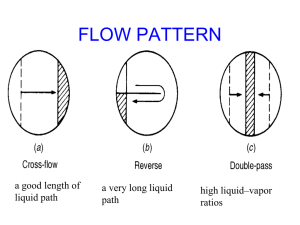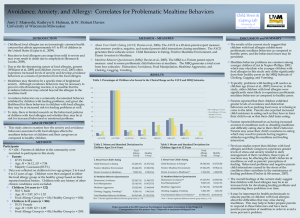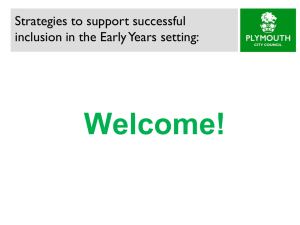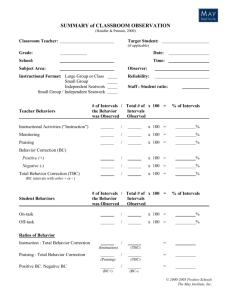PlayfulTray_Ubicomp07
advertisement
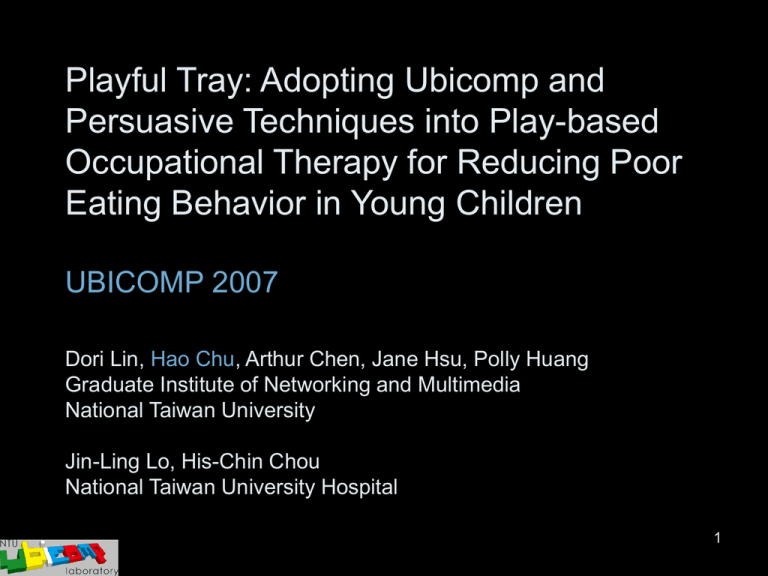
Playful Tray: Adopting Ubicomp and Persuasive Techniques into Play-based Occupational Therapy for Reducing Poor Eating Behavior in Young Children UBICOMP 2007 Dori Lin, Hao Chu, Arthur Chen, Jane Hsu, Polly Huang Graduate Institute of Networking and Multimedia National Taiwan University Jin-Ling Lo, His-Chin Chou National Taiwan University Hospital 1 Child Behavior Training • Child behavior training as important but challenging parental responsibility – Potty training, tooth brushing, self-dressing, cleaning room, slow eating (focus of this work) • The most common form of parental persuasion is verbal persuasion. – “if you don’t finish your food, you are going to sit here for the rest of your life”. • Effective and Why not? – Verbal persuasion alone lacks proper incentive to motivate child 2 A Case Study: Child Mealtime Behavior • Target child long mealtime problem (over 30 minutes) – Affect the participation of daily activities – Negative parent-child interaction • Dinner time supposed to be valuable family time together • Common scenario: A child refuses to eat -> Mother upset -> Mother force feed -> Child upset 3 Play-based Occupational Therapy • Pediatric occupational therapy (O.T.) – Leverage the desire of children to play to induce their behavior change willingly. • A child may not like to sit & eat dinner, but likes to play. • Add playfulness (game) into the eating activity – Effective – full of toys in pediatric O.T. clinic. 4 Play-Based O.T. Limitations (1) Children treated in clinics during regular office hours (NTU Hospital) – Many child behavior problems not observable to therapists • Eating (dinner time), sleeping (night time), etc. • Effective treatment is difficult. (2) Train general performance skill rather than specific functional skill – Hand scoping skill vs. eating skill – Improvement in general performance skills may not translate into specific functional skills 5 UBICOMP Opportunities • Embed digital technology into a child naturalistic living environment – Sensing to observe child behavior anytime, anywhere – Game playing to influence child behavior anytime, anywhere • Occupational therapist perspective: – From treatment clinic – To the child actual living environment (functional behaviors) • UBICOMP perspective: – From sense and track behaviors – To engage children to change behaviors • Also called Persuasive technology (by Fogg and others) 6 Playful Tray Prototype 1: Coloring Game • Sensing – Weight sensors underneath tray detect child eating actions – Eating actions are game input • Playing – An interactive game of coloring a cartoon character – To fully color the cartoon character, a child is motivated to eat. • Is this design successful? 7 Why not? Show prototype #1 to our pediatric O.T. partners, their feedbacks are two questions: • Do you think the child would pay attention to playing the game or eating (enjoying) food? • What would happen if parents take away the tray after a while? – Intervention (Effective) – Post (Ineffective) Guess their opinions from their questions … 8 Play-based Occupational Therapy Model • Treatment program is about designing a play activity (three elements). Volition Bring enough enjoyment to attract a child to participate in the target activity. Performance Ensure a child will have a successful experience. Set appropriate level of difficulty. Habituation Apply reinforcement to reward good performance, so increase change of repeating desirable behavior. Enough times to become a habit. 9 Design Consideration • Attention (Child) – Split between playing and eating – Game playing (secondary) not overtaking eating (primary, target) • Enjoyment (Game) – Bring just enough fun to attract children to eating • Engagement (Game) – Simple (Not all young children can learn to operate complex devices) – Use natural eating actions as game inputs • Child must eat to continue playing (eating becomes self-inforced) 10 Prototype 1: Problems • Disengagement – Grabbed too much attention & distract children from proper eating. • Gobbling – Impatient children ate too quickly (to color cartoon character). • Single weight cell is sufficient – Food is served in one bowl to a young child (at home or school). 11 Prototype 2: Racing Game Tray Palm-top PC with touch screen For placing the bowl Weight sensing surface 12 The Racing Game 13 The Racing Game • No reward for eating too fast 14 Racing Game Tray: Feedbacks • Tray was too thick (3 cm) – Inconvenience for young children with short arms • Playing the same game boring – Download new games • Expensive • Difficult to wash 15 Prototype 3: Mobile Penguin Fishing Tray Bluetooth mobile phone accessory Placemate skin Light, foldable, washable, changeable Weight sensing module 50% Thinner (1.5 cm) Mobile Phone Download new games Only buy the skin & weight sensing model 16 Install weight sensing module 17 Game start Child selects a penguin to compete in a fishing game. 18 Game start Each bite causes one penguin to get a fish The penguin getting more fish at the end wins Child is motivate to help in order to help penguin to win. 19 Pilot User Study on Prototype #2 • Conducted by our pediatric O.T. team • Subjects: four young children with reported long mealtime problems (30 min to over 1 hr) Children Age Diagnosis A 7 Asperger’s Syndrome B 5 High function autism C 5 Asperger’s Syndrome D 4 No specific diagnosis 20 User Study Procedure 1. 2. 3. 4. Child’s Mealtime Behavior Checklist Interview - to clarify behavioral details Record eating activities without the tray Record eating activities with the tray within 1 week 21 Measurement method • Code behaviors of both children & parents from taped videos • Our eating coding behavior table was modified from Moore. – Self-feeding (Positive, Negative) • Child active feeding or related behaviors – Interaction (Positive, Negative) • Actively initiated behaviors and synchronous responsive behaviors of the feeding partners – Social • Toward a feeding partner but unrelated to feeding – Positive (promote self-feeding); Negative (interrupt self-feeding) 22 (1) Self-feeding: a child place food into his/her own mouth Mother Child Positive: A child attempts self-feeding, such as Positive: A mother allows or promotes self-feeding, holding utensils, putting food into mouth, such as verbal encouragement, praises, etc. etc. Negative: A mother discourages, disallows, or interrupts self-feeding, such as pushing the Negative: A child rejects self-feeding, such as saying “no” or pushing away given food. child’s hands away, telling the child that she will feed the child, etc. (2) Interaction: Actively initiated behavior and the synchronous responsive behavior of the feeding partner Mother as the actor Child’s responsive behavior Positive: A mother attempts to arouse a child’s Positive: A child accepts food when it is offered, interest, such as talking about food, models, or self-feeds food. Negative: A child ignores the mother’s cue, food games, etc. A mother refocuses the child’s attention on food when the child is refuses, or walks away from the mother’s distracted. cue. Negative: A mother intrusively attempts to direct Positive: A child responds by self-feeding. feeding, such as force-feeding the child, Negative: A child ignores the mother’s attempts, holding a child’s head, body, or hand, and refuses, or walks away from the mother’s threatening the child. attempts. Mother’s responsive behavior Child as the actor Positive: A mother synchronously responds to promote continuous feeding, such as Positive: A child initiates an attempt to eat, such interpreting a child feeding cues, responding as looking at food, talking about food, to a child’s needs, etc. requesting food/drink, or touching food. Negative: A mother synchronously responds to interrupt the child’s feeding. Positive: A mother synchronously responds to 23 promote continuous feeding, such as Negative: A child shows disinterest, interpreting the child feeding cues, Measurements (with vs. without the tray) • • • • Mealtime duration Child on-task / off-task behavior ratio Parent on-task / off-task behavior ratio Parent positive / negative behavior ratio 24 Result: Mealtime Duration • (A:23, B:40, C:41, D:25) -> (23, 25, 29, 9) • Except for Child A, children B, C, D all had reduced mealtime from 29% ~ 64%. Mealtime duration (min) Mealtime duration without the tray with the tray 50 40 30 20 10 0 A B C D Participants 25 Measurements (with vs. without the tray) • Mealtime duration • Child on-task / off-task behavior ratio – On-task behaviors: positive behaviors – Off-task behaviors: negative + social behaviors – High ratio is good. • Parent on-task / off-task behavior ratio • Parent positive / negative (P/N) behavior ratio 26 Child On-task/Off-task Behavior Ratio • Improvement in all children – Children were more focused on self-feeding with the playful tray Child behavior without the tray On-task/Off-task behavior 7.0 with the tray 6.0 5.0 4.0 0.8~1.6 3.0 2.0 1.0 0.0 A B C Participants D 2.3~5.9 27 Measurements: with vs. without the tray • Mealtime duration • Child on-task / off-task behavior ratio • Parent on-task / off-task behavior ratio – On-task behaviors: positive behaviors – Off-task behaviors: negative + social behaviors – High ratio means good improvement. • Parent positive / negative behavior ratio 28 Parent On-task/Off-task Behavior Ratio • Improvement of all parents – Parents were also more focused on the feeding task with the playful tray. On-task/Off-task behavior Parent behavior without the tray with the tray 2.5 2.0 0.5~1.1 1.5 1.0 0.5 0.0 A B C Participants D 0.8~2.3 29 Measurements: with vs. without the tray • • • • Mealtime duration Child on-task / off-task behavior ratio Parent on-task / off-task behavior ratio Parent positive / negative behavior ratio 30 Result: Parent P/N Ratio • Less negative & more positive interaction between parent-child. – A positive interaction cycle of parent giving encouragement and children responding with positive self-feeding behaviors – Mealtime experience can be good. 0.79~4.00 4.30~30.00 31 Limitation • Pilot user study results were encouraging but not conclusive – Lack long-term user studies involving more children – Lack post-intervention study • What happened when taking away the tray? • For O.T., success = improvement from posttest to pretest. Pre Intervention Post 32 Conclusion • This work demonstrates a case study of adopting UBICOMP technology in play-based occupational therapy for children – Pilot user study results were encouraging 33 Ongoing & Future Work (Children have lots of behavior problems) • Playful toothbrush – Tooth brushing behavior – Sensing: camera vision to recognize brushing motions – Playing: an game of cleaning dirty teeth • Mug-Tree – Regular water drinking habit – Sensing: tilt sensor to detect drinking actions. – Playing: watering a virtual tree 34 Many Thanks • Reviewers for their insightful comments • Our shepherd Sunny Consolvo • Keng-hao Chang on helping to create the first prototype 35 Thanks Q&A 36 Result: Child P/N Ratio • Child negative behaviors decreased 0.80~13.33 6.95~19.00 37 different food types (rice/ dumpling→easy to eat → less self-feeding actions) ↑


